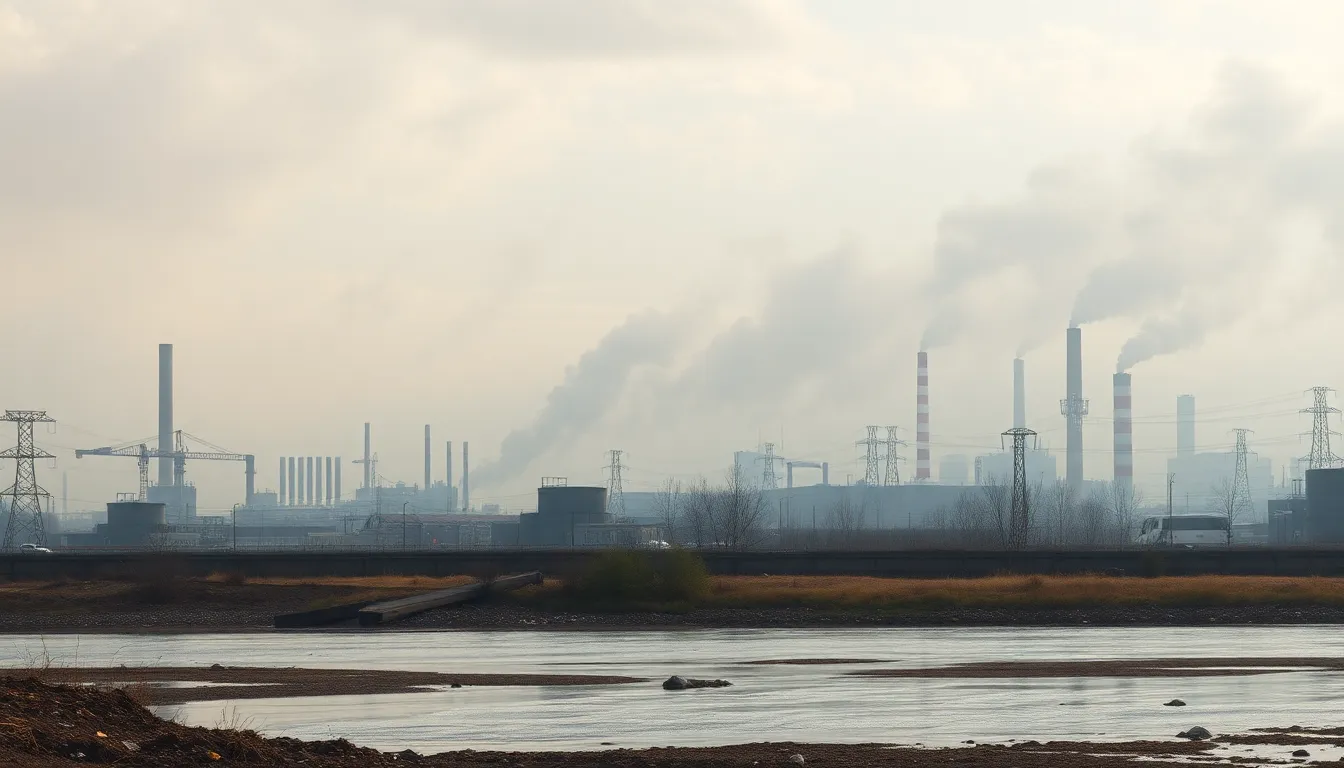Pollution isn’t just an eyesore; it’s a sneaky villain lurking in plain sight, ready to wreak havoc on health and the planet. From smoggy skies to plastic-filled oceans, it’s like the Earth’s version of a bad hair day that just won’t go away. If only Mother Nature had a good stylist to help her out!
Table of Contents
ToggleOverview of Pollution Dangers
Pollution poses significant risks to public health and the environment. Air pollution contains harmful particles, leading to respiratory diseases and cardiovascular issues. Water pollution affects drinking supplies and aquatic life, disrupting ecosystems and human communities. Soil contamination results from chemicals and waste, impacting agriculture and food safety.
In urban areas, smog creates visibility issues, exacerbating respiratory problems. According to the World Health Organization (WHO), 4.2 million deaths occur annually due to outdoor air pollution. Noise pollution contributes to stress and sleep disturbances, affecting overall well-being.
Plastic waste in oceans creates severe hazards for marine life. Sea turtles ingest plastic bags, mistaking them for jellyfish, while fish consume microplastics, leading to harmful effects in the food chain. Freshwater bodies face similar threats, as pollutants like heavy metals accumulate in fish populations.
Climate change accelerates pollution dangers, with increased temperatures worsening air quality. Greenhouse gas emissions, primarily from burning fossil fuels, drive global warming, resulting in extreme weather patterns. Ocean acidification impacts marine ecosystems by altering the pH levels.
Regulatory measures serve as essential tools in combating pollution. Air quality standards limit emissions from vehicles and industries, while wastewater treatment protocols safeguard water resources. Public awareness campaigns encourage responsible waste disposal and recycling practices.
Collective action remains crucial to mitigate pollution dangers. Individuals can reduce their carbon footprint by using public transport, conserving energy, and minimizing plastic usage. Communities gain strength through advocacy for stricter environmental regulations and sustainable practices.
Types of Pollution

Pollution manifests in various forms, each presenting unique hazards to both health and the environment. Understanding these types allows for better management and mitigation strategies.
Air Pollution
Air pollution emerges from activities like industrial emissions and vehicle exhaust. This contamination comprises harmful particles and gases, including nitrogen dioxide and sulfur dioxide. Breathing polluted air leads to respiratory diseases and cardiovascular problems. According to the World Health Organization (WHO), outdoor air pollution accounts for 4.2 million deaths globally each year. Urban areas, with dense traffic and industrial activities, experience heightened pollution levels. Effective measures, such as implementing regulatory standards, aim to curb these emissions.
Water Pollution
Water pollution occurs through the introduction of harmful chemicals and waste into water bodies. Human activities like agricultural runoff and sewage disposal contribute significantly to this issue. Polluted water sources disrupt ecosystems and endanger marine life. Contaminated drinking water can lead to serious health risks, including gastrointestinal diseases and neurological disorders. Statistics show that millions lack access to safe drinking water, emphasizing the need for efficient waste management. Strategies such as wastewater treatment and stricter regulations help address this pressing challenge.
Soil Pollution
Soil pollution results from the accumulation of toxic chemicals and waste in the ground. Agricultural practices, industrial discharges, and improper waste disposal are primary contributors. Contaminated soil affects food safety, as pollutants can enter the food chain. Crop yields suffer from diminished soil quality, affecting agriculture and farming communities. The presence of heavy metals and pesticides poses long-term risks to public health. Remediation techniques, including bioremediation and soil management practices, provide viable solutions for restoring soil health.
Health Impacts of Pollution
Pollution significantly impacts public health, with both short-term and long-term effects evident in various populations. Direct exposure to polluted environments poses immediate risks that can become severe over time.
Short-Term Effects
Short-term effects of pollution manifest quickly after exposure. Common symptoms include respiratory issues, headaches, and eye irritation. Many people experience these issues following high pollution days, particularly in urban areas. Children, the elderly, and individuals with preexisting conditions face heightened vulnerability to these short-term impacts. Air pollution can trigger asthma attacks, leading to emergency room visits. Noise pollution disrupts sleep patterns, increasing stress levels and contributing to fatigue. With air quality deteriorating, the likelihood of these symptoms rises, negatively affecting daily activities and overall quality of life.
Long-Term Effects
Long-term effects of pollution build over time, often leading to chronic health conditions. Prolonged exposure to polluted air contributes to heart disease, lung cancer, and other serious diseases. Studies indicate that extended exposure can shorten life expectancy. Prolonged contact with contaminated water sources can lead to severe gastrointestinal diseases and reproductive issues. Soil pollution threatens food safety, leading to health complications for consumers. Continued reliance on fossil fuels increases greenhouse gas emissions, exacerbating respiratory conditions in sensitive populations. Undoubtedly, long-term pollution effects lead to systemic health challenges, necessitating urgent intervention and policy changes.
Environmental Consequences
Pollution presents numerous environmental challenges, significantly impacting ecosystems and human health.
Climate Change
Climate change exacerbates pollution’s effects on the planet. Increased temperatures elevate air pollution levels, especially in urban environments. Air quality suffers due to vehicle emissions and industrial discharges. According to the World Health Organization, polluted air contributes to 4.2 million deaths annually. Greenhouse gas emissions further accelerate global warming, resulting in severe weather events. These drastic climate shifts negatively affect agricultural production and water resources, threatening food security.
Biodiversity Loss
Biodiversity loss stems from pollution-related factors. Aquatic ecosystems face severe threats from plastic waste and toxic runoff. Marine animals ingest plastics, leading to injury and death. Terrestrial pollution impacts soil health, reducing habitat quality for numerous species. According to research, nearly one million species are at risk of extinction due to habitat destruction and pollution. Sensitive species, particularly in vulnerable ecosystems, experience population declines. Preserving biodiversity relies on addressing pollution and implementing sustainable practices across industries.
Mitigation Strategies
Effective strategies can reduce pollution’s impact on health and the environment. These approaches involve policy, public engagement, and community actions.
Policy and Regulation
Implementing strong regulation serves as a cornerstone for pollution mitigation. Establishing air quality standards, as recommended by the World Health Organization, can significantly lower respiratory disease rates associated with outdoor air pollution. Enforcing protocols for wastewater treatment helps protect drinking supplies and aquatic life. Local governments can create urban planning policies that prioritize green spaces to combat heat and improve air quality. Community involvement in forming regulations enhances accountability and leads to tailored solutions for specific local needs.
Public Awareness and Education
Raising public awareness plays a pivotal role in pollution reduction efforts. Educational campaigns can inform individuals about the importance of reducing plastic waste and recycling practices. Schools can incorporate environmental science into their curricula, fostering a new generation that understands the dangers of pollution. Social media outreach can effectively engage diverse audiences, emphasizing simple actions like proper waste disposal. Advocating for sustainable lifestyle choices builds collective responsibility and encourages community-driven initiatives.
Pollution poses a significant threat to both human health and the environment. The impacts are far-reaching affecting air quality water sources and soil integrity. With millions of lives claimed annually due to pollution-related diseases it’s clear that urgent action is necessary.
Communities must come together to advocate for stronger regulations and sustainable practices. Public awareness and education play crucial roles in fostering responsible behaviors that can mitigate pollution’s effects. By embracing collective action individuals can contribute to a healthier planet for future generations. A commitment to reducing pollution is not just an environmental issue; it’s a vital step toward safeguarding public health and preserving biodiversity.





